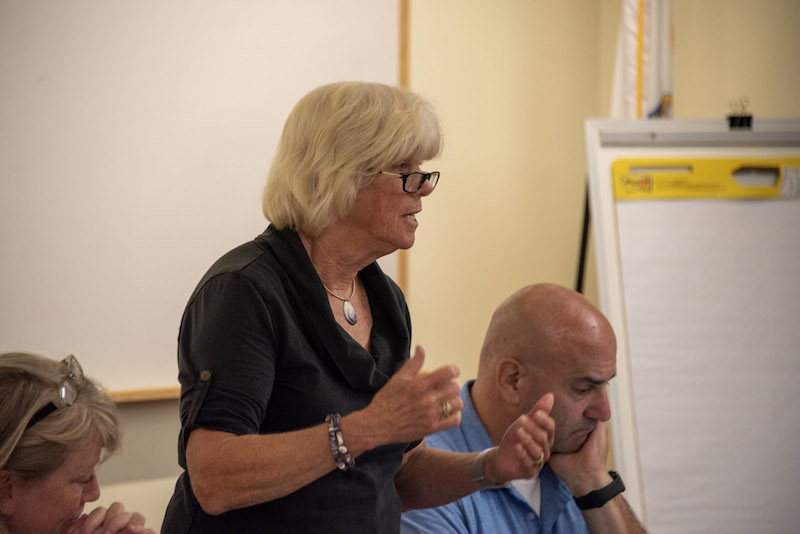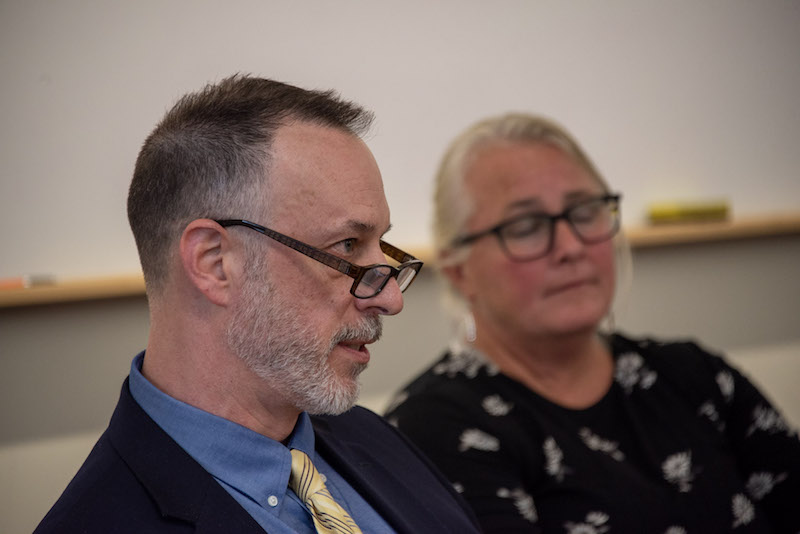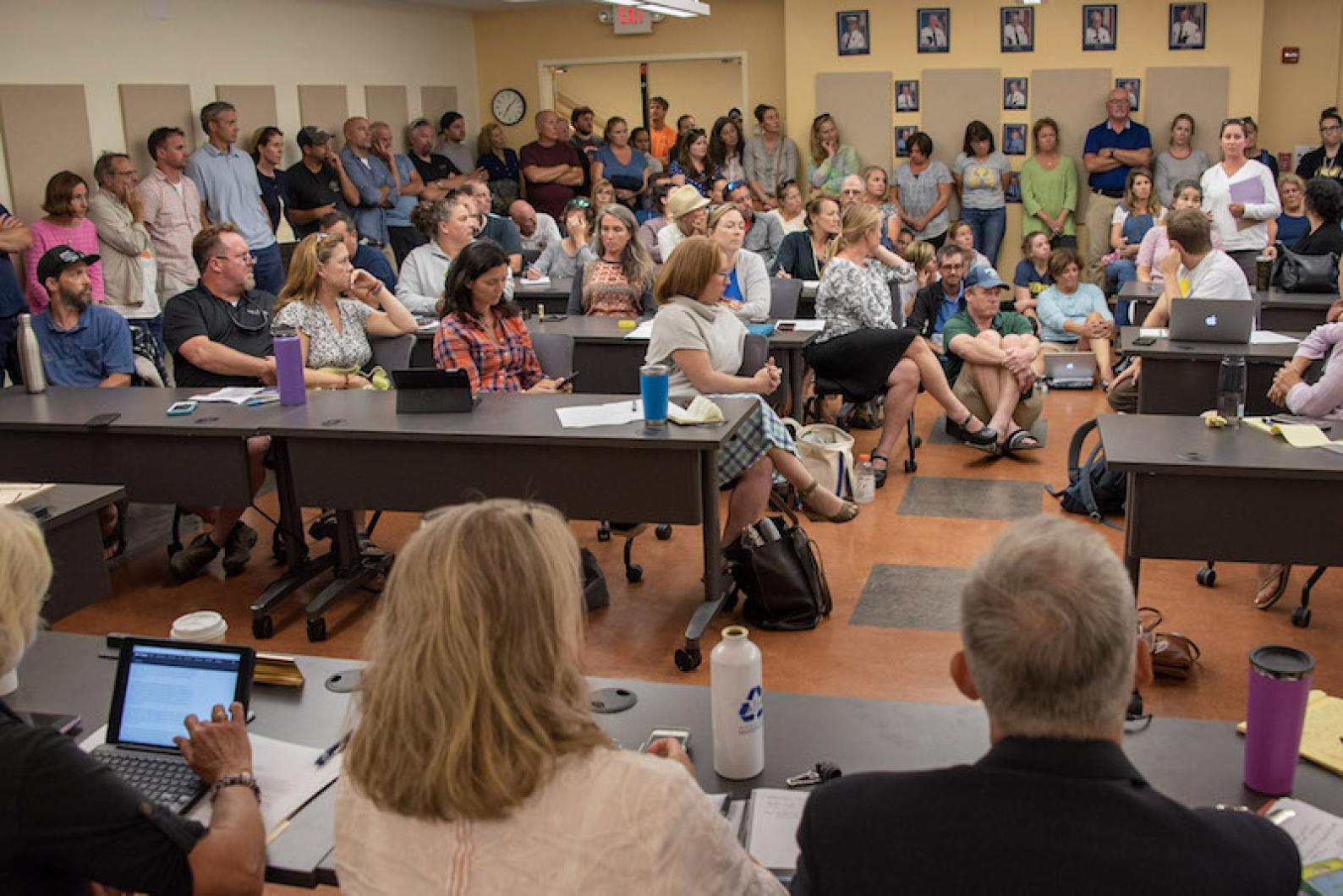One week after a report revealed unsafe levels of chipping lead paint in nearly a dozen rooms at the Tisbury School, a community of teachers, staff, administrators, public officials and parents remains at odds over a daunting — and mounting — set of problems at the aging brick school that dates to 1929.

And while other Island children dust off their backpacks and lunchboxes to go back to school on Sept. 3, Tisbury families will see the start of school delayed by a week, and their children divided between separate campuses. “This has been, as you can imagine, a very, very challenging situation,” Vineyard schools superintendent Matthew D’Andrea told the up-Island school committee Tuesday.
After a flurry of meetings in the past two weeks, school leaders have decided that Tisbury students in grades K through four will attend classes in a 1993 wing of the school that has no lead paint problems. Students in grades five through eight will be bused to the regional high school, where a contained area of classrooms has been cleared to accommodate the young students, teachers, a school nurse and other support staff. The first day of school for all Tisbury students will be Sept. 9.
But how long the children will remain in the temporary classrooms and whether and when the problems at the aging school will be remediated is still unclear.
According to Mr. D’Andrea, officials learned the results from the lead testing on Tuesday of last week. One day later, they announced a hastily sketched plan to delay school and relocate students. An initial plan to put lower school students at Camp Jabberwocky was subsequently swapped for the current plan to use the 1993 wing of the school for the younger kids.
The crisis has mobilized other members of the Island community to come to Tisbury’s aid. School choice has been reopened, the hospital will provide free lead testing for Tisbury students, and the YMCA will provide a week of child care for families, at the expense of the town. Tisbury selectmen have scheduled a special town meeting for Sept. 24 to seek $1.5 million for temporary modular classrooms and other costs associated with the lead paint remediation.
Meanwhile, some parents and officials have openly questioned whether spending money now on limited remediation efforts makes sense in light of still unresolved issues of whether to renovate or replace the old school.
At a trio of meetings on Tuesday, school leaders wrestled with the complicated logistics of relocating students two weeks before school was to reopen. The tests for lead paint and other hazardous material were undertaken at the request of parents and teachers. Mr. D’Andrea said school officials had hoped to get the testing done earlier in the summer, but difficulties getting licensed inspectors to the Island delayed the testing until August. And while school officials had considered potential scenarios for the testing results, they did not expect the news they received last week, he said.
But the meetings also sparked political fallout from frustrated parents, who singled out the Tisbury selectmen for blame over the failure of a proposed new $46 million school project in 2018.
“The reason we are here is a complete failure of leadership in our town,” said parent Siobhan Mullin at a joint meeting of the selectmen and school committee held at the town emergency services facility. “When a school does not open in a town, the town has failed . . . you should all be ashamed of yourselves. You should consider resigning. Our town needs a complete overhaul of leaders that we can trust.”

Her remarks drew applause from other parents in the room, many of whom echoed “hear, hear” chants during and after she spoke. Nearly 100 parents filled every seat and spilled into the hallways.
Selectman Jim Rogers was not present in person, but participated by speaker phone. Selectman Jeff Kristal was just elected in April.
But Melinda Loberg, the only selectman present at the meeting who had served on the board during 2018 school vote, instead placed blame on school officials.
“I think there is a misunderstanding on the part of the town about the responsibilities of the parties to perform and do certain things,” Mrs. Loberg said. “The school committee is solely responsible for the school, the educational program, and the building. The town hall and the staff that we supervise and oversee are responsible for preparing the warrant and budget that we approve.”
Parents peppered the officials with questions for over an hour about the reality of the changes.
Some worried about whether their children had already been exposed to health risks from lead in the school.
“The Massachusetts childhood lead poisoning prevention program says that anything above a 1.0 is a dangerous level. In the classroom that my child has spent a year in last year, the levels were at 18.8 to 19.3,” said Angie Francis, referencing a report made public Tuesday. “How do you feel about that?”
A consultant’s report commissioned in 2017 when Tisbury was seeking grant funding from the Massachusetts School Building Association found lead paint in the school building, but did not recommend a major removal effort.
Mrs. Loberg took no formal position on the school project in 2018, while former selectman Tristan Israel opposed it. She also said the school committee never asked for money from town meeting to remediate the issues with the building. As for the 2018 failed project, she said it was the voters who decided.
“I know we had a project that would have addressed everything, but the town did not vote to support it,” she said.
On Tuesday, however, the room erupted in anger and resentment toward Mrs. Loberg.
“You sabotaged that project!” one parent responded over the din. “That was the school asking you for the funds and telling you what they needed, and you sabotaged it.”
“The board opposed everything,” another said.
“It was the selectmen who didn’t support the project. It failed by 20 votes [in the ballot box]. Not even one of you could stand up and represent that half of the town,” said another parent.
School committee chairman Amy Houghton asked parents to calm down. But the divide between the parents and Mrs. Loberg was evident throughout the meeting, as she remained dug into her position, saying she could not support what she termed a “blank check” school project, citing the town’s high tax burden.
Principal John Custer, moved to tears, took responsibility for the state of the building.
“I feel responsible for everything that happens in the school. That comes with the job. I accept it and love it,” he said. “And I’m sorry we’re here.”
Meanwhile, school leaders must now decide whether it is worth fixing lead paint in a building with a long list of other problems.
“We can’t keep looking at this building and say we need to band-aid it,” Mrs. Houghton said later. “We can’t fix the paint without fixing the ventilation system. And you can’t fix the ventilation system without fixing the windows. It goes down this whole path. This is a comprehensive problem within the school. It is not something that is an easy fix.”
She also refuted claims by Mrs. Loberg that the school committee did not seek funds for repairs at the school.
She said the school committee asked for six figures worth of maintenance money in the first draft of their budget last fall — and selectmen requested they remove it.
“I think there was a misrepresentation . . . that the school hasn’t come asking for help, or that the school hasn’t wanted money. And that’s absolutely not true,” Mrs. Houghton said.
She continued: “I think the bigger issue is how do you build going forward? And how do you stop pointing fingers? Because that’s what we need to do.”
Mr. D’Andrea admitted there was a lot of responsibility to go around, including the school committee, the selectmen, and himself.
“All of those people up front were responsible, myself included,” the superintendent said. “We’ve got to do a better job. I don’t think any of us could stand up and say we’re not responsible. Something like this cannot happen again.”
He also said he would support a new school project, especially considering that children will be in temporary classrooms.
“There are going to be a lot of conversations and discussion over the next few months about what we are going to do moving forward,” Mr. D’Andrea said. “I am in support of saying, hey, they are in the modulars, let’s get a building project done.”








Comments (58)
Pages
Comments
Comment policy »